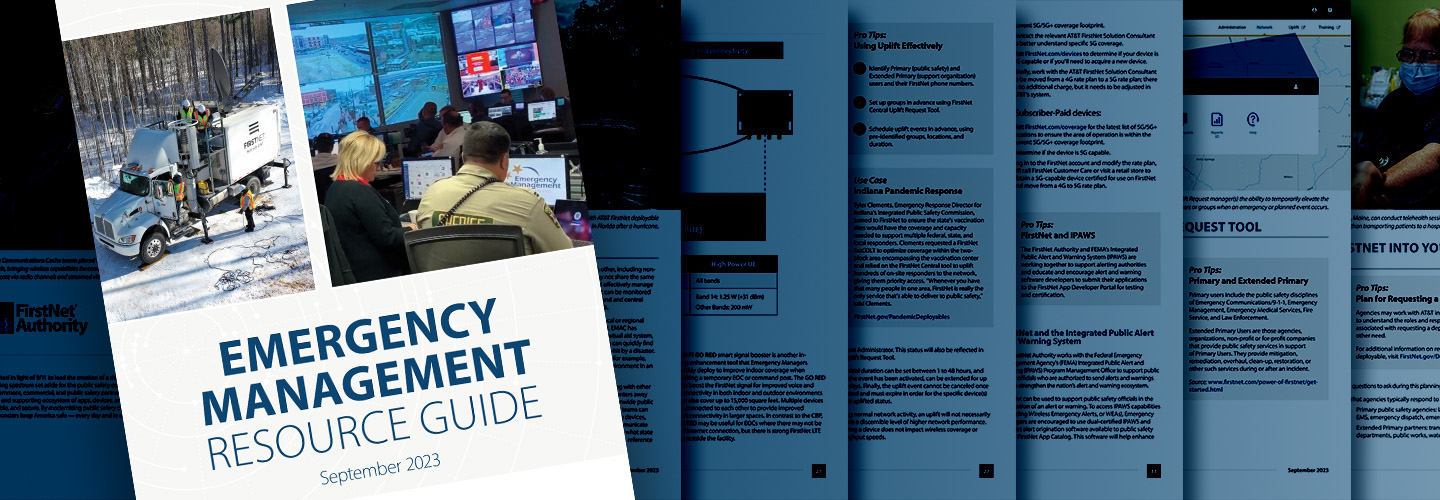The FirstNet Authority Emergency Management Guide was developed by experts in FirstNet solutions and emergency management operations to help public safety plan for events or incidents. The guide is a comprehensive outlook for incorporating broadband into your communication plans and emergency management efforts.
The latest version of the guide, published September 2023, features three new sections highlighting:
- FirstNet’s mission critical services
- Network enhancements unique to FirstNet
- New versatile deployable solutions
FirstNet’s mission critical services
Mission critical is defined as any factor of a system (such as equipment, a process, a procedure, software, etc.) that is critical to the success or failure of mission operations. Within the world of public safety, a tool or service may be deemed “mission critical” when public safety users decide it’s required for successful response operations. The FirstNet Authority works with public safety to assess whether a tool or service is mission critical to their operations.
Two mission critical services covered in the guide are push-to-talk over FirstNet and Z-axis location tracking.
Push-to-talk over FirstNet helps create a common operating picture of an incident for responders in the emergency operations center and in the field. You can use it to connect with individuals or entire talk groups to share critical information, such as voice communications, pictures, and video.
With FirstNet’s Z-axis location tracking, users can track the vertical location of first responders indoors and in multistory buildings. FirstNet’s Z-axis location tracking can improve situational awareness and responder safety, enhance the effectiveness of incident management, and reduce response times.
Mission critical services are covered in Section 2 of the FirstNet Authority Emergency Management Guide.
Network enhancements unique to FirstNet
First responders have unique communication needs because they work in all types of scenarios. That’s why FirstNet offers new ways to stay connected, no matter where public safety is at work.
Two of FirstNet’s unique network enhancements are high-power user equipment and the indoor coverage enhancing Cell Booster Pro.
High-power user equipment, or HPUE, boosts signal power up to six times the normal strength. The increased signal extends coverage in rural areas and provides stronger building penetration when in or near structures. HPUE gives public safety devices the power to create and maintain a connection to the network when traditional devices might slow or drop off entirely.
Cell Booster Pros are helpful tools in buildings where there is insufficient coverage — whether due to the building’s structure, layout, or geography. The Cell Booster Pro acts as a miniature cell tower to bring FirstNet service indoors and can be used in emergency operations centers and other buildings where public safety works.
Unique network enhancements are highlighted in Section 4 of the FirstNet Authority Emergency Management Guide.
New versatile deployable solutions
The FirstNet deployable fleet has new versatile options to help public safety boost connectivity in harder-to-reach places.
One of the newest members of the fleet is the Compact Rapid Deployable (CRD). CRDs are smaller units that can be quickly deployed to provide coverage in locations where larger vehicles can’t go. CRDs will fit through most doorways and can be transported in a pickup truck, helicopter, or boat.
The miniCRD is a portable version of the CRD, consisting of two rugged cases that are the size of checked luggage. One case contains the satellite backhaul connection to the network, and one contains the cell site equipment to create the local connection to FirstNet devices.
Both CRDs and miniCRDs are available for individual agencies to purchase and own, allowing emergency managers to extend FirstNet coverage in remote, damaged, or congested areas, at their own direction and on their own timeline.
These new deployables are covered in Sections 1 and 4 of the FirstNet Authority Emergency Management Guide.
Public safety feedback
These new sections of the FirstNet Authority Emergency Management Guide were created based on feedback we heard from the emergency management community. They gave us valuable insights into the topics covered by the guide.
Public safety feedback is at the heart of the FirstNet Authority’s mission. Do you have thoughts about public safety broadband for emergency management? Have you used the guide in your daily operations or for incidents? What else would you like to see addressed in the Emergency Management Guide? Contact your public safety advisor to share your thoughts and experiences.




















